Hello again Zoners! Long time no see! Indeed, your old Grandpa Growth ran into a patch of bad internets and blew a tire on the information super highway. Shortly after the BotG set review was finished I started having some problems that are not yet resolved, so we will just hope I can post at least on my regular days. I will attempt to throw in some Snap Keeps and You Make the Picks when I can, but it could be a stretch until I have a proper internet connection.
But you guys don't want to hear about that! You want to hear about games, strategy, psychology, the fun stuff that I talk about every week in my regular column (this column) In General. Before the set review went up I had just completed a three part series about investing, in the gaming sense. How to commit resources to profitable ends, how to compare multiple investments, and how to decide which is the best use for your resources. You can find those articles here:
Part 1,
Part 2,
Part 3. This is important to mention because today's topic is closely related to the points I made in the investment series. You see, today we are going to talk about vehicles.
So What is a Vehicle Grandpa?
When I say vehicles, some will think of those potentially annoying, potentially awesome missions in shooter games where they give you a jeep, unlimited ammo, and an unholy horde of bad guys to riddle full of holes. I am not talking about that kind of vehicle. A vehicle is the 'thing' you sink your resources into when you invest. Examples from finance are stocks, bonds, ETFs, etc. Vehicles are the set of all possible uses for your resources, broken down into discreet categories based on their similarities of input and output. Let's look at the card types in Magic and I will show you what each different vehicle gets you.
Types of Vehicles In Magic
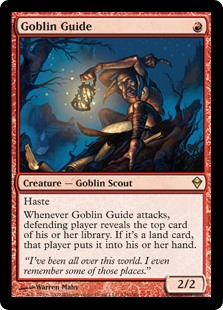 |
Goblin Guide is leading the league in
points. He is well known for his ability to
put opponents on a clock from the
beginning of a game. |
Creatures (Threat) - An aggressive creature is looking to do damage. Decks capitalize on this by building a critical mass of threats early on in the game and dealing lethal damage before more powerful cards can stabilize the board. Almost always these Creatures cost some amount of mana and one card. You put you card from hand onto the battlefield and hopefully it pays off in a steady stream of damage over the next few turns.
It is important to mention that playing a threat is almost always a tempo-neutral play, but removing a creature is not. You gain tempo from threats by playing more than one at a time or playing more than your opponent can remove. You lose tempo on a threat when the opponent kills your expensive guy with a cheap removal spell AND does something else that is relevant with the mana he saves. I see a lot of internet rhetoric concerning tempo that is unclear about what it means in the game so I need to make this point clear: If I play a guy on my turn, then you kill it on your turn and pass back to me, there was no change in tempo. It sucks that my guy bit the dust, but our relative resources stayed the same from beginning to end, we both lost the same amount of stuff: some mana, one card, and one turn's worth of time.
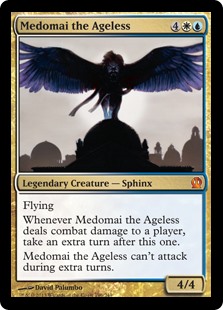 |
In a somewhat strange new example,
Medomai literally CREATES time by
giving you extra turns. That is value. |
Creatures (not threats) - We just learned how a threat can net tempo by taking away your opponent's FUTURE time. Some Creatures, earn you tempo not by taking it away from an opponent, but by making more of it for you. People often talk about these as "defensive creatures" and it is true that many Defender cards and other assorted "big booty" Creatures accomplish this task very well, but remember that defensive creatures only give you tempo that you would have lost to an opposing threat. If you play a
Steel Wall and your opponent never attacks and instead kills you with
Tendril's of Agony, your Creature didn't get you any tempo at all. The general case though, is this: Playing a defensive Creature costs mana and a card. It doesn't damage to an opponent, but instead prevents damage to you. Which, as stated, gives you back the time that you would have lost.
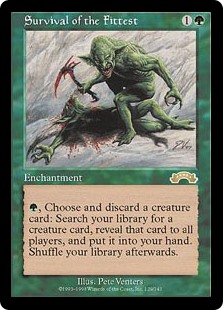 |
A Haiku: Engines are great, they win games.
This card is broken.
Poetry is difficult. |
Engines - An engine is simple in theory, but sometimes more complex in execution. You build the engine. Then every time you feed it fuel you get some output. This differs from other 'investichantments' in that you have to pay to make it work in addition to having a down payment just to create the option. The returns are heavily quantized and, in some cases, even further delayed. Thankfully though, Magic has been kind to engines over the years. Many of the game's defining decks run these kinds of cards. Unfortunately, they are difficult to categorize because the costs, inputs, outputs, and overall quality of each, is unique. This is a small, but diverse category full of easily broken cards like
Necropotence and
Sliver Queen.
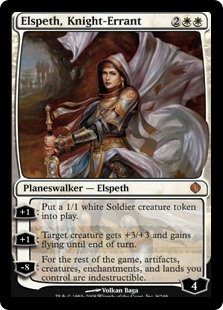 |
Elspeth put 'dubs on the map. Shards of
Alara brought the infant card type to new
heights of power on the back of this card. |
Planeswalkers - This category is even more difficult to evaluate because the outcomes of the investment vary so widely. All planeswalkers though cost mana and a card, most are expensive enough to require an entire turn's worth of mana to play, but they are difficult to remove. Often they will require multiple attacks or a combination of removal in order to deal with them. The payoff comes from activating the loyalty abilities, which you can do once every turn. These incremental returns are obvious, but there is also the internal 'subgame' of ticking the planeswalker up towards the ultimate or down to get value, all the while trying to protect it from attackers. The best planeswalkers allow you to generate more of a core resource on every turn. If you can tick up to gain life, cards, or access to more mana, then you are very likely to win a longer game.
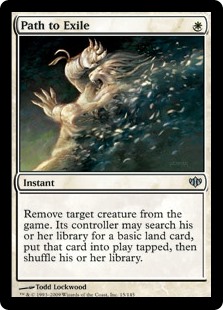 Removal and Disruption
Removal and Disruption - A lot of Instants and Sorceries fall into the category of destroy/discard/counter target NOUN. The basic formula for this is that we are trading a card in hand and a very small amount of mana for primarily TIME. Why do you kill creatures? So that you won't die, pretty simple. It is easy to work backwards and apply that concept to countering a threat on the way down or picking it out of their hand with a Thoughtseize. When you use disruption, you are trying to slow down or outright STOP your opponent from doing something. Certain strategies that require key cards, like combo decks, are very vulnerable to disruption. Whereas strategies with few card types and lots of redundancy, like Red Deck Wins, are harder to disrupt and generally bounce back faster.
Magic is a large, old, and incredibly complex game. This is only a samll handful of the most common vehicles for investment, but there are plenty more that occur regularly like card draw or mana acceleration. Nearly every card in the game comes with some resource investment attached. This is a broad principle that you must consider when designing a strategy: what resources are you investing? What are you investing them in? What are the weaknesses and strengths of those investments AND how can you take advantage of what your opponent has invested? The answers to these questions are the key to the game. Understanding resource management is a fundamental, critical skill that casual players under-consider.
Well that's about enough for today Zoners! Coming up next week on TGZ we are back with a new edition of The Stack, a new You Make the Pick with Born of the Gods, and regularly scheduled posts of from the guys.
-GG

No comments:
Post a Comment